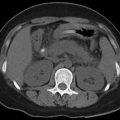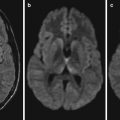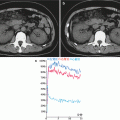© Springer Science+Business Media Dordrecht and People’s Medical Publishing House 2015
Hongjun Li (ed.)Radiology of Infectious Diseases: Volume 110.1007/978-94-017-9882-2_2828. Severe Fever with Thrombocytopenia Syndrome
(1)
Department of Radiology, Beijing You’an Hospital, Capital Medical University, Beijing, China
Severe fever with thrombocytopenia syndrome (SFTS) is a tick-borne zoonosis caused by severe fever with thrombocytopenia bunyavirus (SFTSV), a newly discovered bunyavirus. The common clinical symptoms of SFTS include fever, leukopenia, thrombocytopenia, and multiple organ failure. This disease was firstly identified in China in the year of 2009.
28.1 Etiology
SFTSV belongs to the genus of phlebovirus in the family of Bunyaviridae. The viruses are spherical or ellipsoidal particles with a diameter of 80–100 nm, which is enveloped by double-layered lipid membrane. The particle has spines of glycoproteins on the surface and the nucleocapsids composed by viral genome and nucleoproteins inside. The viral genome carries three single- and negative- stranded RNA segments, namely, large (L), medium (M), and small (S). The L segment contains 6,368 nucleotides, with open reading frame to encode RNA-dependent RNA polymerase. The M segment contains 3,378 nucleotides, with a single reading frame to encode glycoprotein precursors with 1,073 amino acids. The S segment contains 1,744 nucleotides, with ambisense RNA. The genome of this segment encodes two proteins, the viral nucleoprotein and the nonstructural protein, in both directions. The terminal sequence of the virus genome is highly conserved, with possible formation of panhandle-shaped structure which is highly similar to the features of other phleboviruses at the terminal complementary sequence. The currently existing bunyaviruses have a weak resistance, which are acid intolerant and can be quickly inactivated by heat, diethyl ether, deoxysodium cholate, commonly used disinfectants, and ultraviolet rays. These types of viruses can be completely inactivated by exposure to diethyl ether at 4 °C for 24 h, heat at 65 °C for 30 min, or boiling water at 100 °C for above 2 min. Exposure to ethanol at a concentration of 75 % for 5 min can inactivate the virus, while exposure to chlorine disinfectant containing 10 % effective chlorine for 5 min can inactivate the virus. It has been preliminarily proved that the virus can be inactivated completely by exposure to β-propiolactone at 4 °C for 24 h or to methyl alcohol at 4 °C for 7 days.
28.2 Epidemiology
28.2.1 Source of Infection
Haemaphysalis longicornis is the main source of infection for cases of SFTS. The blood and bloody secretions of the patients at acute phase, both living and deceased, can transmit the disease. And direct contacts to the blood and bloody secretions from the patients can cause the infection.
28.2.2 Routes of Transmission
Bite by the tick carrying the pathogen is the main route of transmission of SFTS. However, some clinical cases have no obvious history of bites by ticks. Direct contact to blood or bloody secretions of the patient is another important route of transmission.
28.2.3 Susceptible Population
Any population is susceptible to SFTS, with no significant occurrence in different genders. The cases are sporadically distributed, and the populations with higher risk of infection include residents, workers, and travelers in mountainous and hilly regions and forests.
28.2.4 Epidemic Features
In China, SFTS is more commonly found in villages of mountainous and hilly areas, especially in provinces of Henan, Hubei, Shandong, Anhui, Liaoning, and Jiangsu, with highly sporadic distribution. Field workers are especially vulnerable to the disease. SFTS more commonly occurs in springs and summers, with a peak incidence during May and July. The cases occurring in the period from May to July occupy 96 % of the total SFTS cases. Sometimes the peak incidence of SFTS may last from May to November.
28.3 Pathogenesis and Pathological Changes
28.3.1 Pathogenesis
The pathogenesis of the newly found bunyavirus is still to be elucidated by more clinical data and laboratory studies. According to the biological features of the virus, most clinicians tend to believe that infection of the bunyavirus induces immediate inflammatory and immune responses, which intermediate immunologically active cells and inflammatory factors to attack host cells. For instance, the invasion of the viruses activates cellular immunity of organisms, especially CD4+ T lymphocytes that secrete a large quantity of IFN-r that intermediate anti-infective effects. While playing a critical role in clearing the pathogens, the overactive immune responses cause tissue damages and severe organ dysfunction.
28.3.2 Pathological Changes
The pathological mechanism of the disease remains unknown. Some scholars assume that the virus may maintain their reproduction in the body by inhibiting target cells to produce antiviral interferon. Their sustained replication induces the production of inflammatory chemokines, therefore triggering immune and inflammatory responses and inflammatory infiltration in tissues of multiple organs and the surrounding vasculolymphatic tissues.
Stay updated, free articles. Join our Telegram channel

Full access? Get Clinical Tree






